
The Bottom Line
Introduction
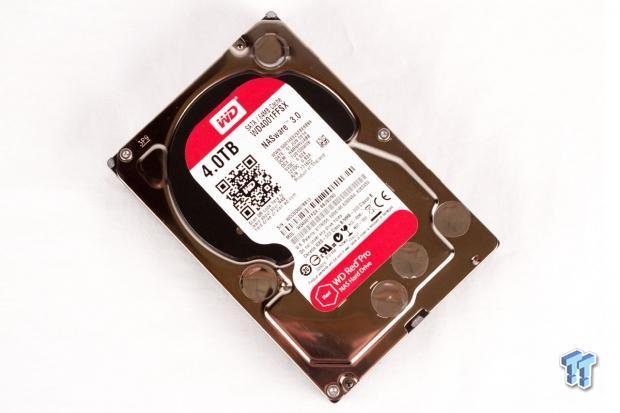
The business class NAS segment has traditionally fallen near the boundary between enterprise class and client HDDs. Administrators typically address these workloads with low-intensity enterprise HDDs such as the Western Digital SE. Western Digital has expanded their popular WD Red, for one to eight bay NAS, to include a new Pro offering geared for eight to sixteen bay NAS applications. The WD Red Pro is designed to address nearline storage requirements in business class, SMB, and SME NAS systems with 2TB, 3TB, and 4TB capacity points in the 3.5" form factor.
Western Digital has improved the functionality of NASware 2.0, found in the client Red series, to Revision 3.0. NASware 3.0 is a suite of optimizations that refine the WD Red Pro for more demanding rack-scale environments. One of the key challenges in larger NAS deployments is increased vibration from the larger number of neighboring drives. Previous generation Red drives utilized software to detect vibration by sensing head position changes during operation.
The WD Red Pro features increased hardware-based vibration resistance that starts with StableTrac technology, which fastens the motor shaft at both ends. 3D Active Balance Plus is a dual-plane balance technology that reduces vibration and noise. The WD Red Pro utilizes RAFF (Rotary Acceleration Feed Forward) multi-axis shock sensors to detect rotational and linear vibration. The drive responds to the corresponding data by utilizing its dual actuators to adjust the fly-height and position of the heads over data tracks. These techniques actually generate less vibration for neighboring drives to compensate for by reducing the vibration of the drive itself. This increases the performance and life expectancy of the WD Red Pro in high vibration applications.
NoTouch ramp load technology utilizes a plastic ramp that secures the actuator, so the heads always stay suspended, and never directly touch the platter. This prevents head crashes when the drive is shut down, in a standby state, or during heavy vibration and acceleration.
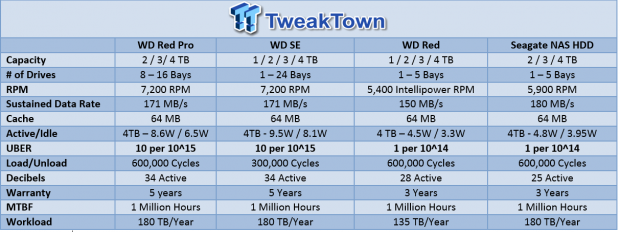
The 4TB WD Red Pro is a five-platter design that utilizes a 6GB/s SATA connection, and a 64MB cache buffer. The Pro's higher performance is primarily provided by the 7,200 RPM spindle speed. This allows it to outperform the client-oriented NAS drives, which spin at 5,400 to 5,900 RPM. Power consumption is higher due to the increased spindle speed of the WD Red Pro and WD SE. The NAS-specific drives also feature higher load/unload ratings of 600,000 cycles due to the more sporadic workloads in NAS environments. The WD Red Pro and WD SE also sport UBER ratings that are similar to the other competitors in the test pool.
The Red Pro drives feature Advance Format technology, and the adjustable TLER (Time Limited Error Recovery) setting is set for seven seconds as a default. TLER prevents the drive from dropping from the RAID array in the event of an error. After the appointed time, the drive stops attempting to correct the error, and communicates it to the NAS. The RAID code can then use parity data to perform a targeted RAID rebuild, which only repairs the affected data, instead of triggering an entire rebuild cycle.
The original Red drives are tested and validated with a large ecosystem of client NAS manufacturers. The WD Red Pro is tested with tower and rack-level manufacturers to extend that same interoperability guarantee to the eight to sixteen bay NAS space. Strict thermal burn-in processes help reduce infant drive mortality rates, and WD provides an enterprise class five-year warranty. One of the other differentiators is a 24 hour dedicated support line for WD Red Pro users.
The WD SE and WD Red Pro offer higher performance than other NAS-specific HDDs, and share many similar characteristics. Let's get them on the bench, and find the real difference between the two drives.
PRICING: You can find the WD Red Pro for sale below. The prices listed are valid at the time of writing, but can change at any time. Click the link to see the very latest pricing for the best deal.
United States: The WD Red Pro (2TB) retails for $144.73 at Amazon, the WD Red Pro (3TB) retails for $179.00 at Amazon, and the the WD Red Pro (4TB) retails for $249.00 at Amazon.
Canada: The WD Red Pro (2TB) retails for CDN$194.47 at Amazon Canada, the WD Red Pro (3TB) retails for CDN$241.79 at Amazon Canada, and the WD Red Pro (4TB) retails for CDN$307.96 at Amazon Canada.
WD Red Pro Internals and Specifications
WD Red Pro Internals
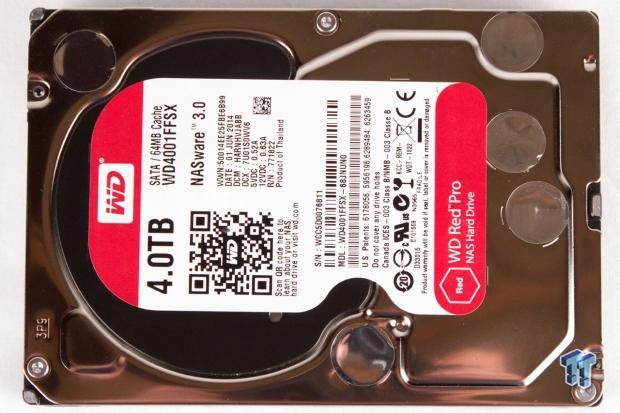
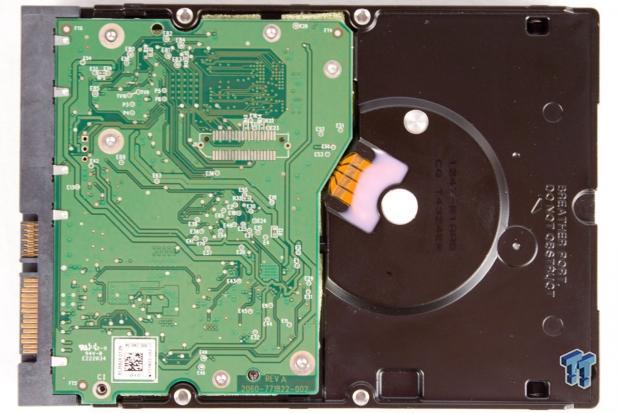
The WD Red Pro comes in the typical 3.5" form factor. The previous generation Red also came in a 2.5" variety, but the Pro version does not. The breather port on the bottom of the drive indicates that this is a standard air filled HDD. The WD Red Pro uses five platters with PMR technology.
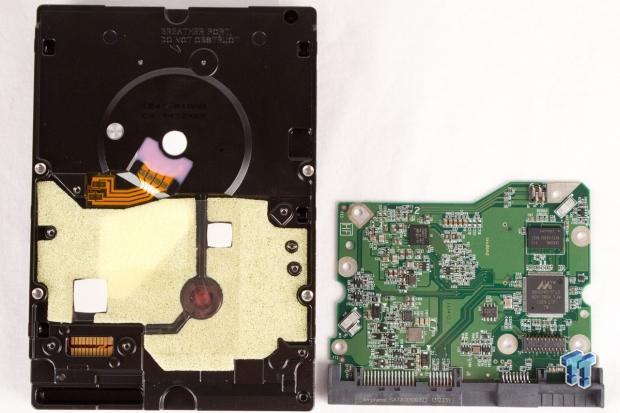
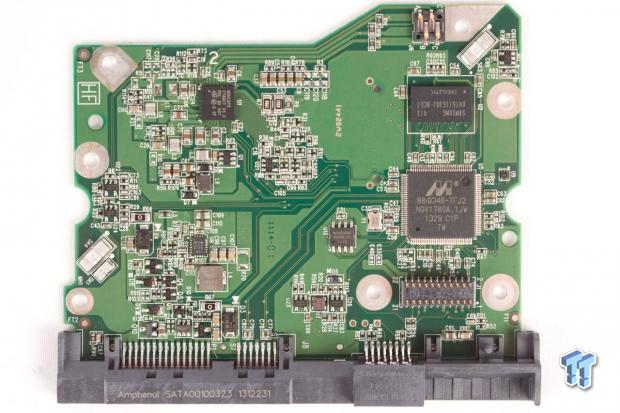
A large foam covering helps to mitigate vibrational forces between the PCB and the case. Two thermal pads facilitate cooling of the drive motor controller (middle right), and the Marvell controller that manages the drive. Two accelerometers occupy opposing corners of the PCB. These detect rotational and linear vibration so the drive can react and correct head positioning.
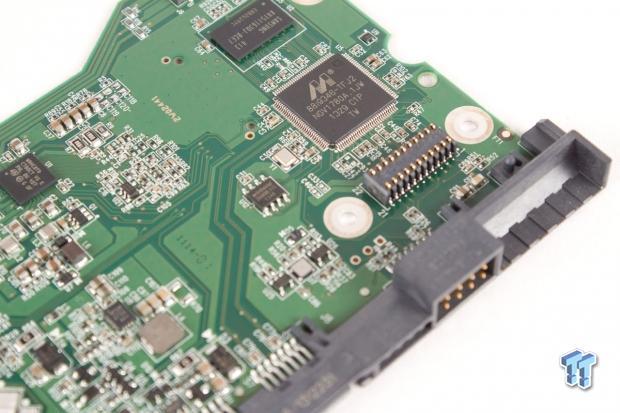
The Marvell 88i9346-TFJ2 controls the WD Red Pro and the Samsung 64 MB multi-segmented cache sets above the controller.
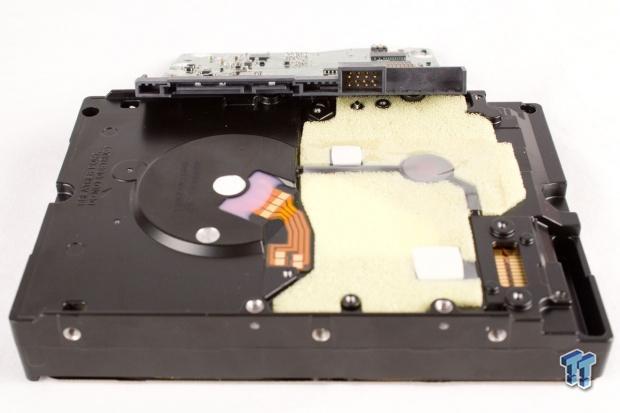
The WD Red Pro features a standard 6Gb/s SATA connection.
WD Red Pro Specifications
The WD Red Pro features Streaming Support, SMART Command Transport (SCT) for monitoring, and power management support. All data is flushed to the platters in the event of power loss. The Red Pro is available in 2TB-4TB capacities, with the WD2001SFFX, WD3001FFSX, and WD4001FFSX part numbers.
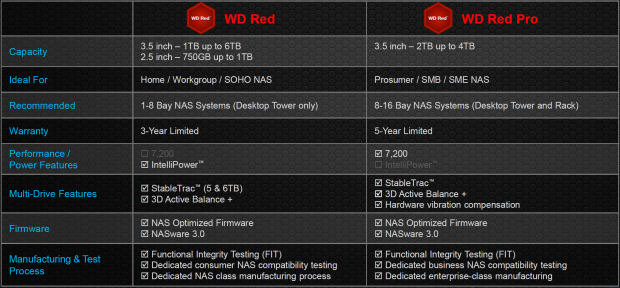
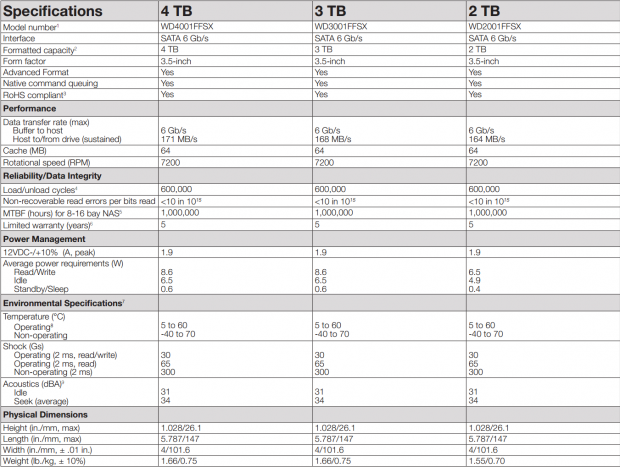
Test System and Methodology
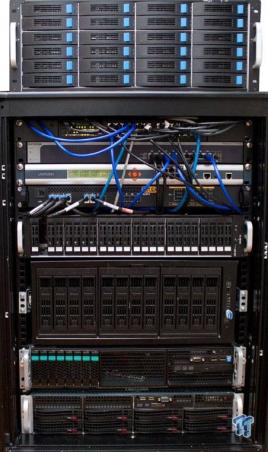

Our approach to storage testing targets long-term performance with a high level of granularity. Many testing methods record peak and average measurements during the test period. These average values give a basic understanding of performance, but fall short in providing the clearest view possible of I/O QoS (Quality of Service).
While under load, all storage solutions deliver variable levels of performance. "Average" results do little to indicate performance variability experienced during actual deployment. The degree of variability is especially pertinent, as many applications can hang or lag as they wait for I/O requests to complete. While this fluctuation is normal, the degree of variability is what separates enterprise storage solutions from typical client-side hardware.
Providing ongoing measurements from our workloads with one-second reporting intervals illustrates product differentiation in relation to I/O QoS. Scatter charts give readers a basic understanding of I/O latency distribution without directly observing numerous graphs. This testing methodology illustrates performance variability, and includes average measurements during the measurement window.
IOPS data that ignores latency is useless. Consistent latency is the goal of every storage solution, and measurements such as Maximum Latency only illuminate the single longest I/O received during testing. This can be misleading, as a single "outlying I/O" can skew the view of an otherwise superb solution. Standard Deviation measurements consider latency distribution, but do not always effectively illustrate I/O distribution with enough granularity to provide a clear picture of system performance. We utilize high granularity I/O latency charts to illuminate performance during our test runs.
We conduct our tests over the full LBA range to allow each HDD to highlight its average performance. All test samples feature 4TB of capacity, but the WD Red Pro and SE models feature a higher 7,200 RPM speed. The first page of results will provide the "key" to understanding and interpreting our test methodology.
Benchmarks - 4k Random Read/Write
4k Random Read/Write
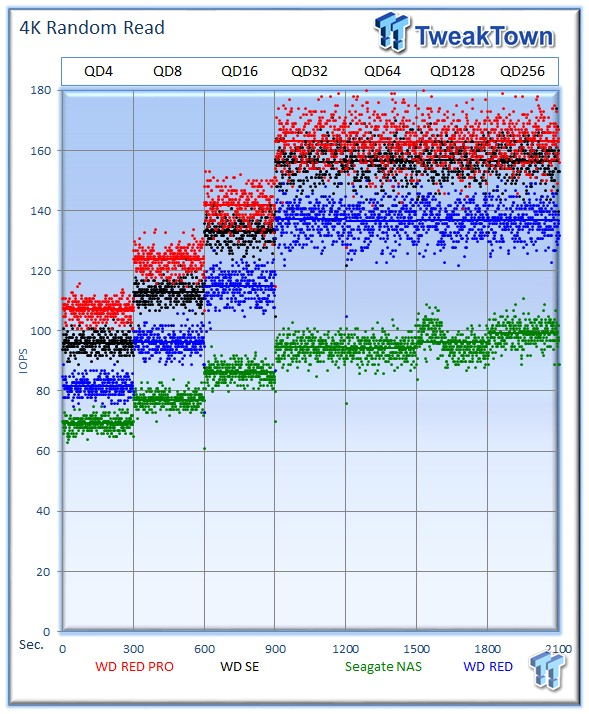
Each level tested includes 300 data points (five minutes of one second reports) to illustrate performance variability. The line for each queue depth represents the average speed reported during the five-minute interval. 4K random speed measurements are an important metric when comparing drive performance, as the hardest type of file access for any storage solution to master is small-file random. 4K random performance is a heavily marketed figure, and one of the most sought-after performance specifications.
The WD Red Pro leads the chart with 163 IOPS at QD256, and the WD SE comes in second with 156 IOPS. The original WD Red scores 136 IOPS, and the Seagate NAS HDD provides 99 IOPS.
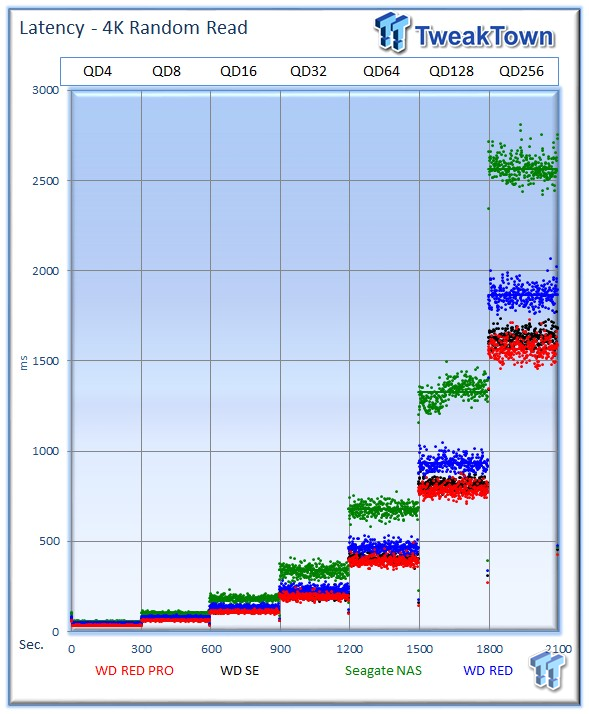
The similarities between the WD SE and WD Red Pro are apparent in their close latency grouping. The Seagate NAS lags behind in latency performance.
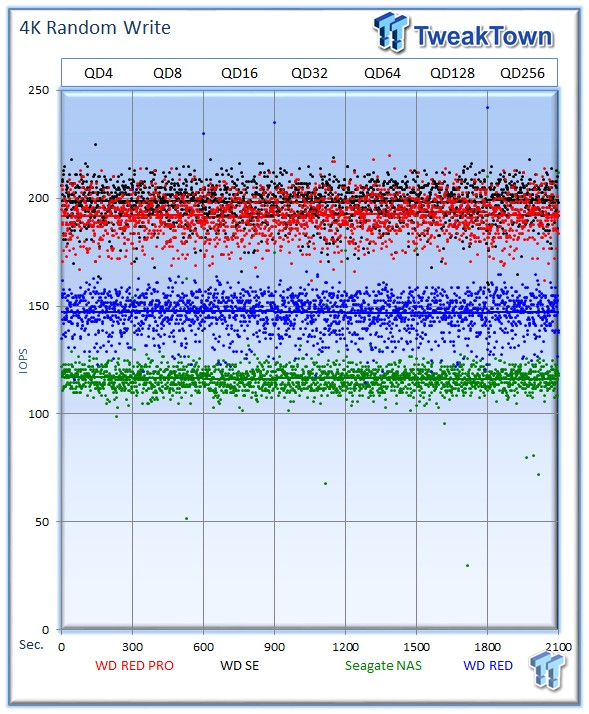
The WD Red Pro averages 192 IOPS; the WD SE takes a slight lead with 198 IOPS; the WD Red provides 147 IOPS; and the Seagate NAS HDD provides 116 IOPS at QD256. The increased speed of the 7,200 RPM WD Red Pro and WD SE is apparent in heavy random workloads.
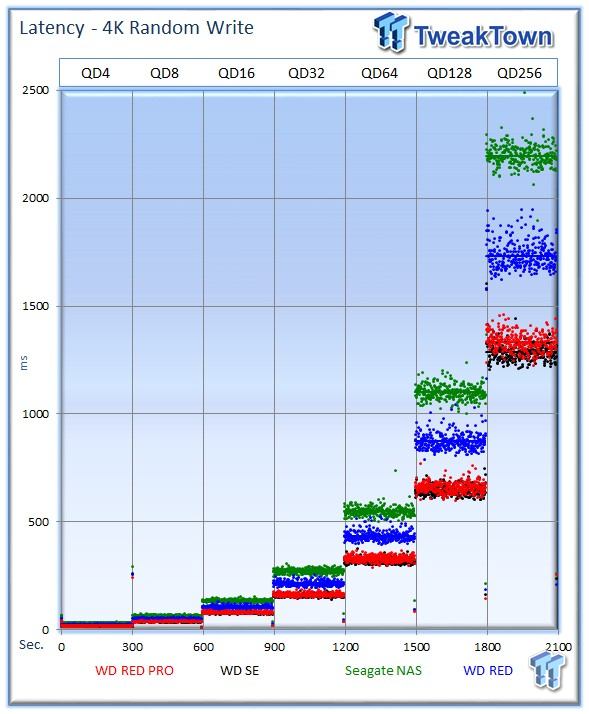
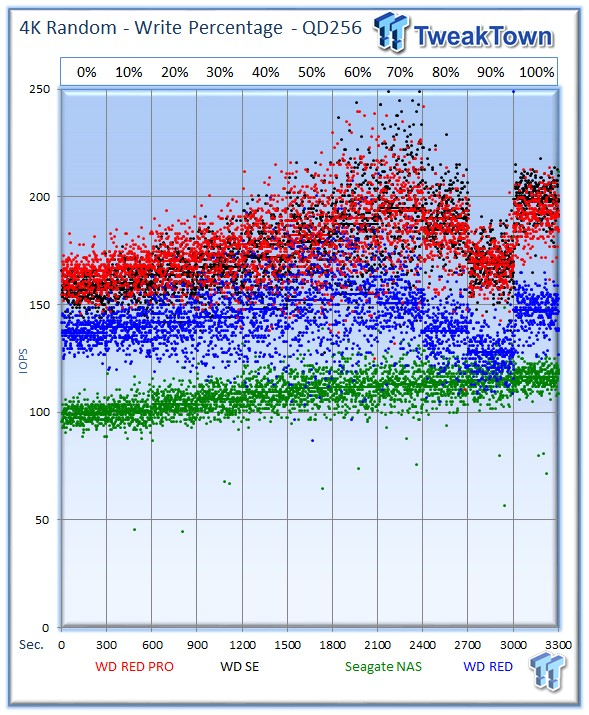
Our write percentage testing illustrates the varying performance of each solution with mixed workloads. The 100% column to the right is a pure write workload of the 4k file size, and 0% represents a pure 4k read workload.
The WD Red Pro and the WD SE trade blows during the test, but easily outpace the slower competitors.
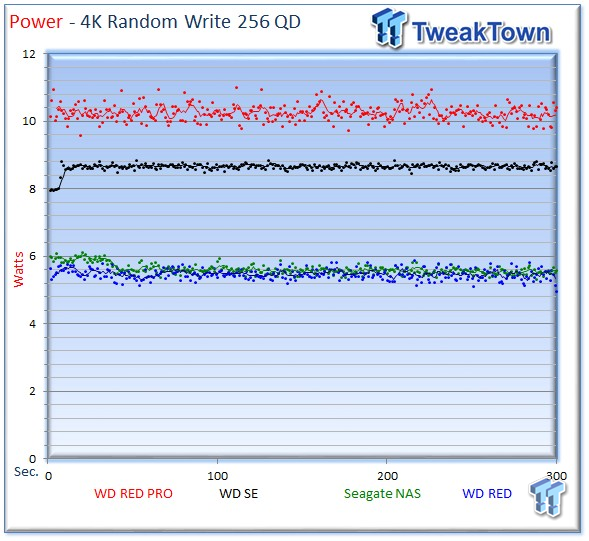
We record power consumption measurements during our test run at QD256. It is important to note the difference in RPM between the WD Red Pro and SE at 7,200 RPM, in comparison to the lower RPM featured in the WD Red and the Seagate NAS HDD. The higher-RPM drives will predictably feature higher power consumption.
The WD Red Pro draws 10.26 watts, the WD SE requires 8.65 watts, the WD Red averages 5.48 watts, and the Seagate NAS HDD requires 5.63 watts.
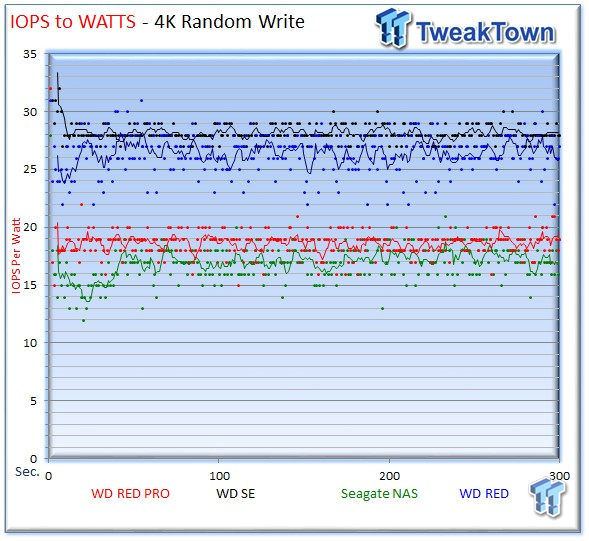
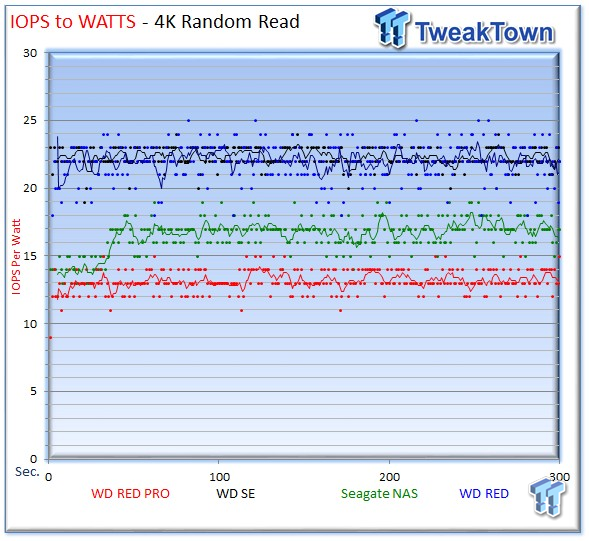
We generate IOPS-to-watts measurements from data recorded during the test period. The WD Red Pro provides 18 IOPS-per-watt during the write workload, and 13 IOPS-per-watt during the read workload. The higher power consumption isn't entirely offset by the increased performance. The SE manages to remain impressively efficient.
Benchmarks - 8k Random Read/Write
8k Random Read/Write
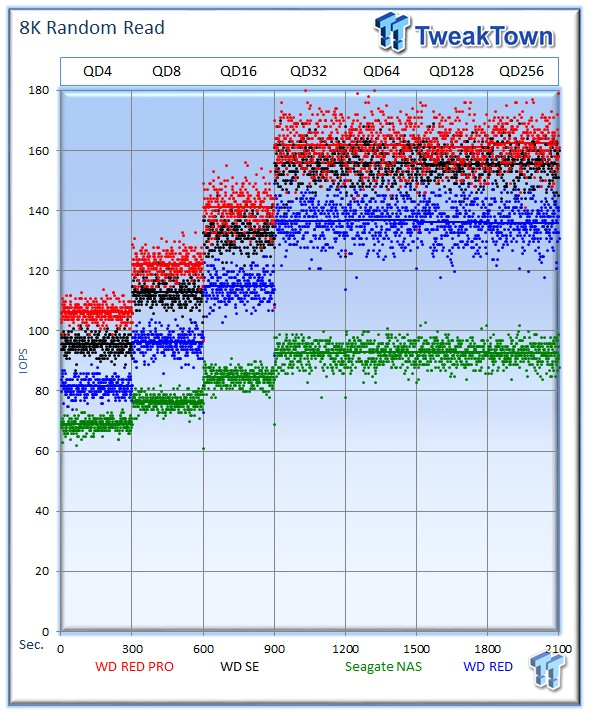
Server workloads rely heavily upon 8k performance and we include this as a standard with each evaluation. Many of our server workloads also test 8k performance with various mixed read/write workloads.
The average 8k random read speed of the WD Red Pro is 162 IOPS at QD256; the WD SE is slightly behind with 155 IOPS, the WD Red offers 135 IOPS, and the Seagate NAS HDD provides 92 IOPS.
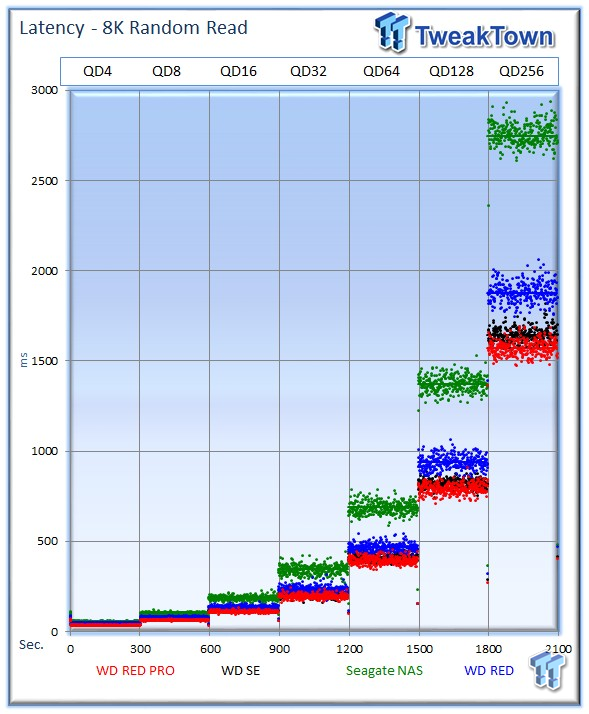
The latency gap between the WD products shrinks with 8k random workloads, while the Seagate NAS HDD continues to lag behind.
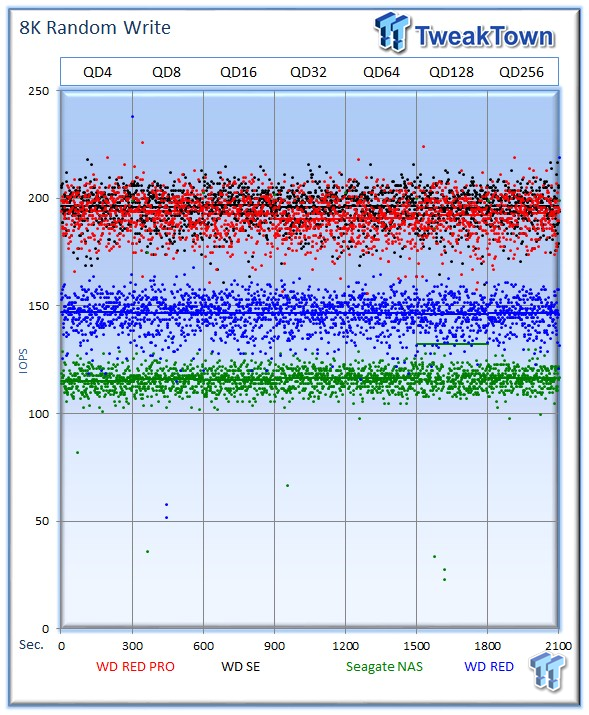
The WD Red Pro averages 193 IOPS at QD256, the WD SE offers an ever-so-slightly faster 196 IOPS, the WD Red provides 146 IOPS, and the Seagate NAS HDD averages 116 IOPS.
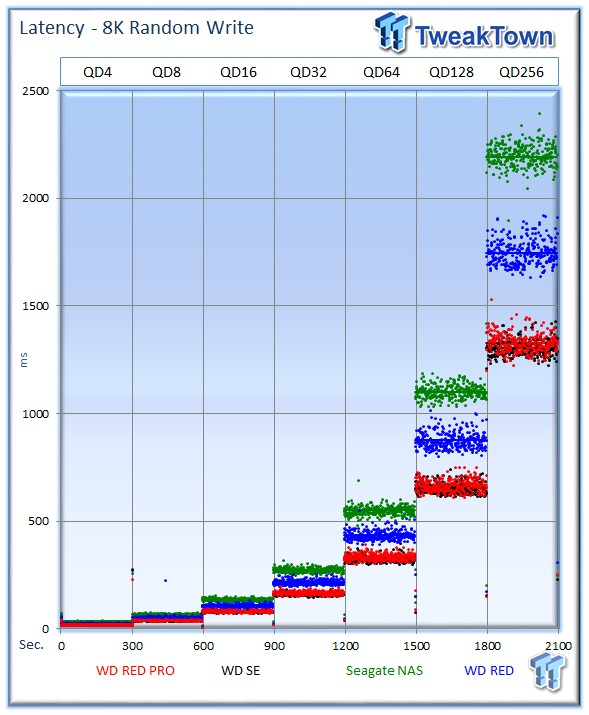
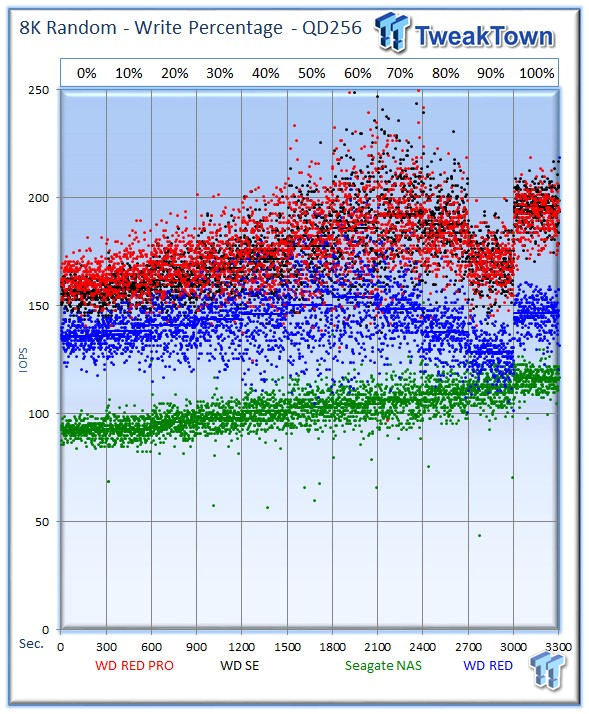
The similarities between the WD Red Pro and the SE are very clear in mixed random workload testing.
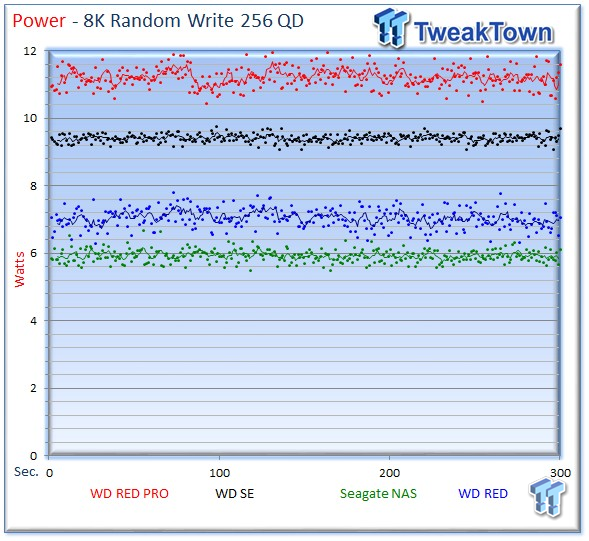
Power consumption for the WD Red Pro is much higher than the competitors' power consumption, coming in at 11.22 watts.
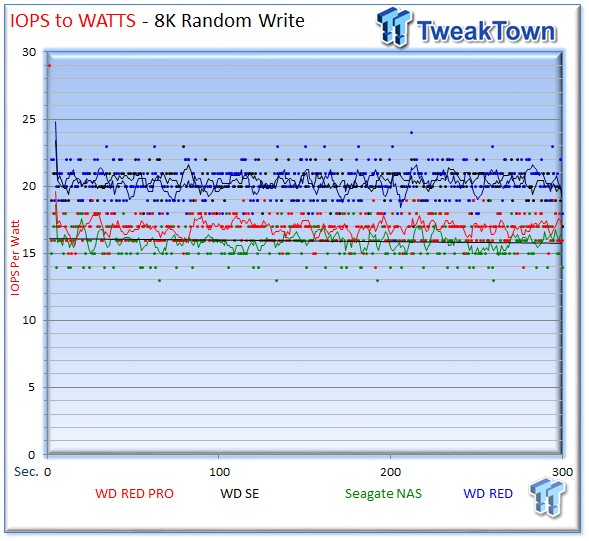

The WD Red Pro remains competitive during the 8k write workload with an average of 16 IOPS-per-watt, but takes the last position with an average of 13 IOPS-per-watt during the read workload.
Benchmarks - 128k Sequential Read/Write
128k Sequential Read/Write
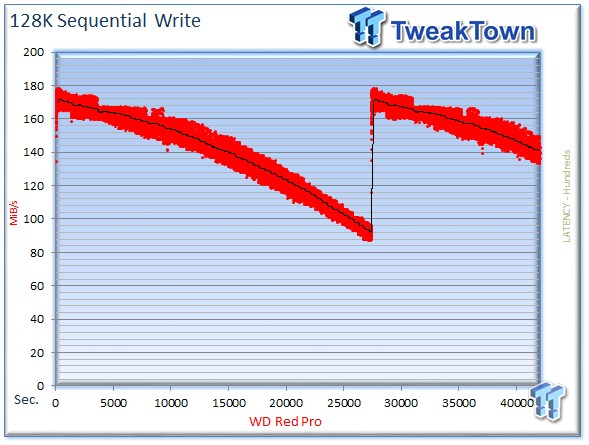
We write to every LBA to highlight performance degradation from the outer to inner tracks of the drive. The drive begins with much higher speed on the outer tracks, and loses speed as it works inward. It required 7 ½ hours to write the entirety of the capacity of the drive, and a sequential read test following the same methodology results in nearly identical results.
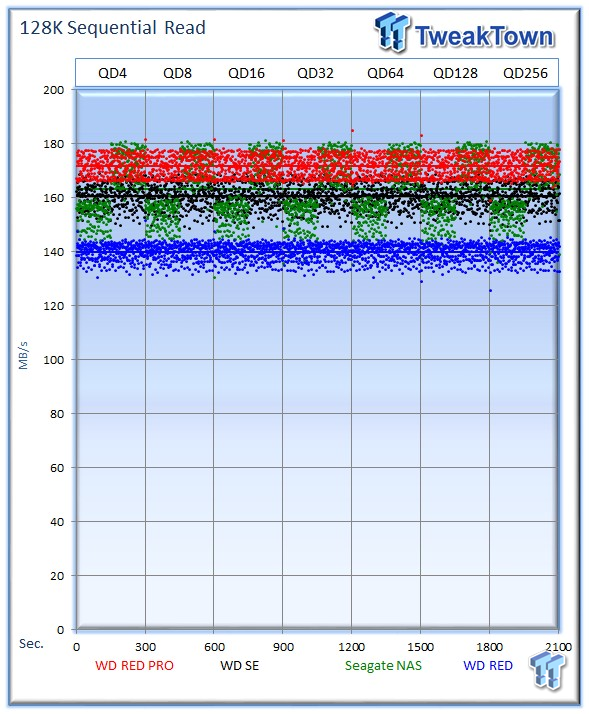
128k sequential speed reflects the maximum sequential throughput of the SSD, and is indicative of performance in OLAP, batch processing, streaming, content delivery applications, and backup scenarios. Today's HDDs are increasingly used for sequential workloads as SSDs encroach upon the application space.
The WD Red Pro easily leads the test with 171 MB/s, distancing itself from the SE's average of 160 MB/s. The WD Red offers the lowest sequential read speed with 139 MB/s; the Seagate NAS HDD provides a staggered performance profile with an average of 163 MB/s at QD256.
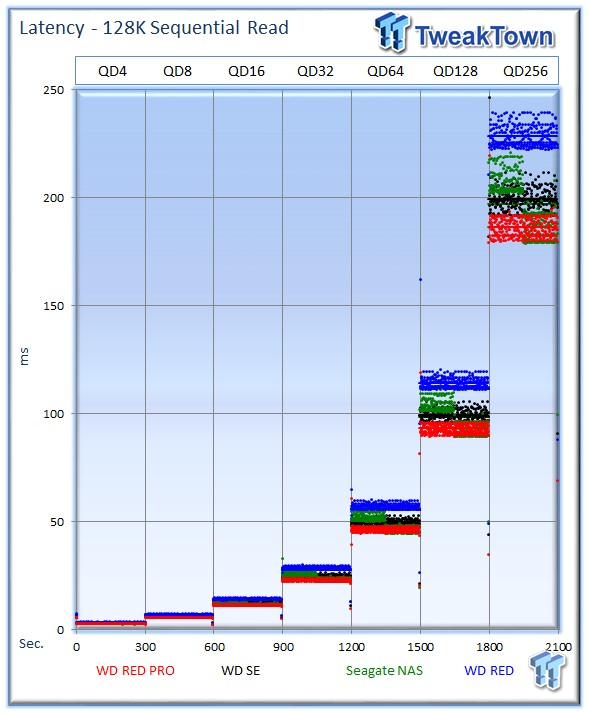
The WD Red Pro offers the best overall latency during every segment of the test.
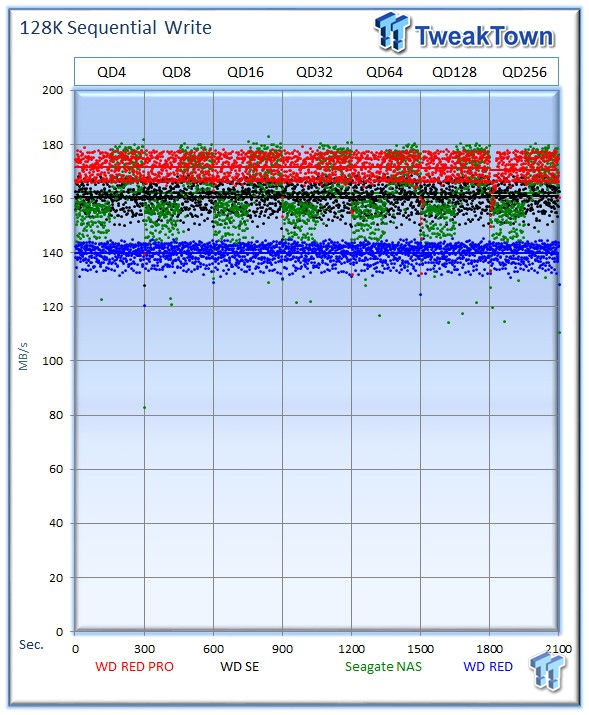
Sequential write performance is important in tasks such as caching, replication, HPC, and database logging. The WD Red Pro provides a leading 170 MB/s at QD256; the WD SE provides 160 MB/s, the WD Red provides 139 MB/s, and the Seagate NAS HDD provides 162 MB/s.
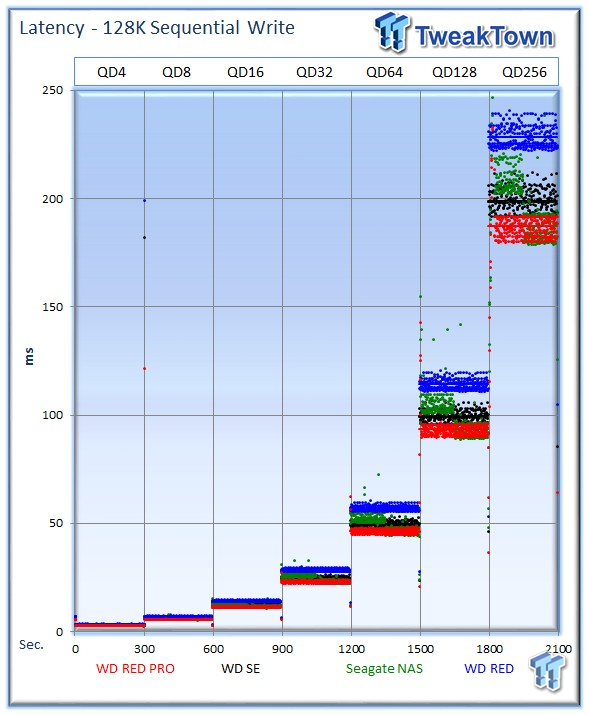
The WD Red Pro again provides the best latency performance during the measurement window.
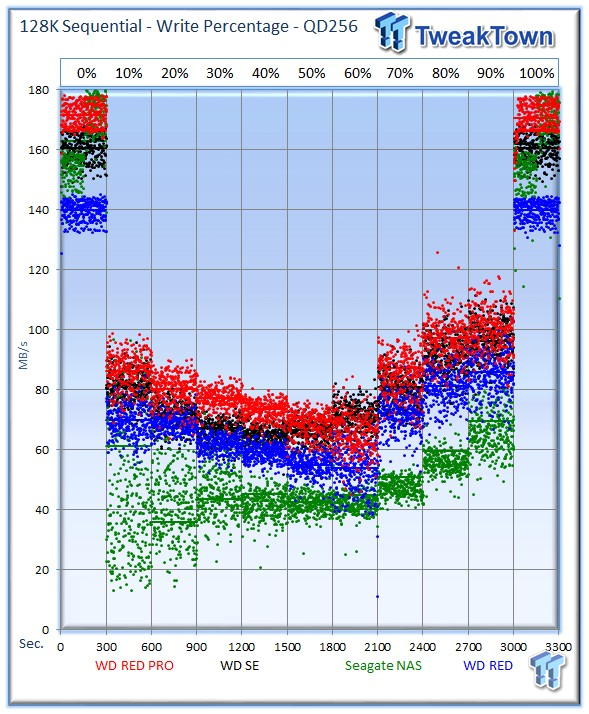
The WD Red Pro continues to display its leading sequential performance in our mixed read/write workload testing.
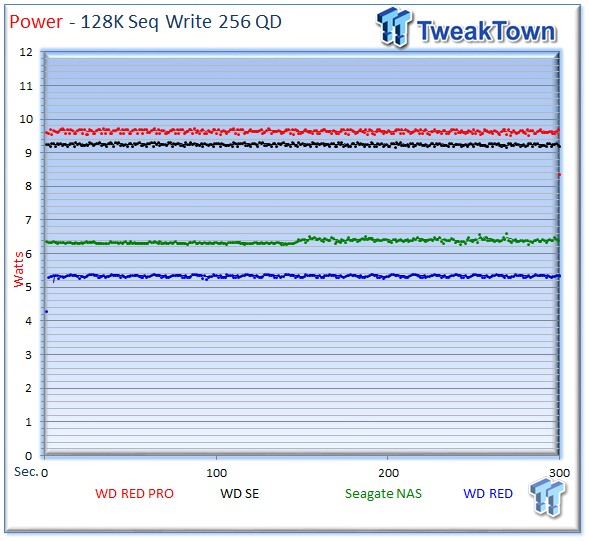
The WD Red Pro continues to draw more power than the other solutions with an average of 9.64 watts.

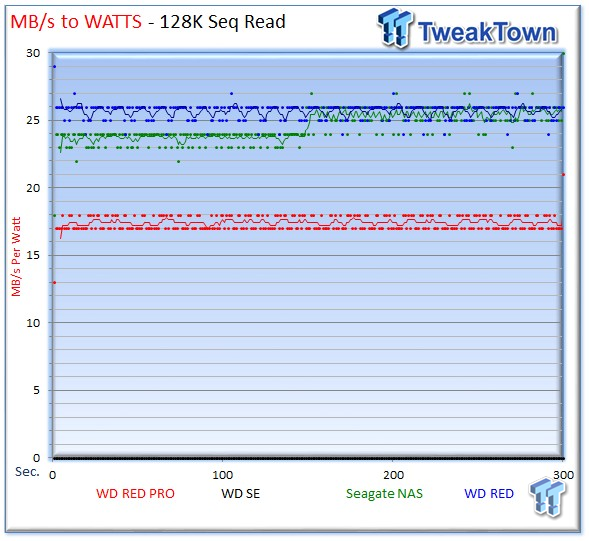
The WD Red Pro offers 17 MB/s for read and write MB/s-per-watt.
Benchmarks - Database/OLTP and File Server
Database/OLTP
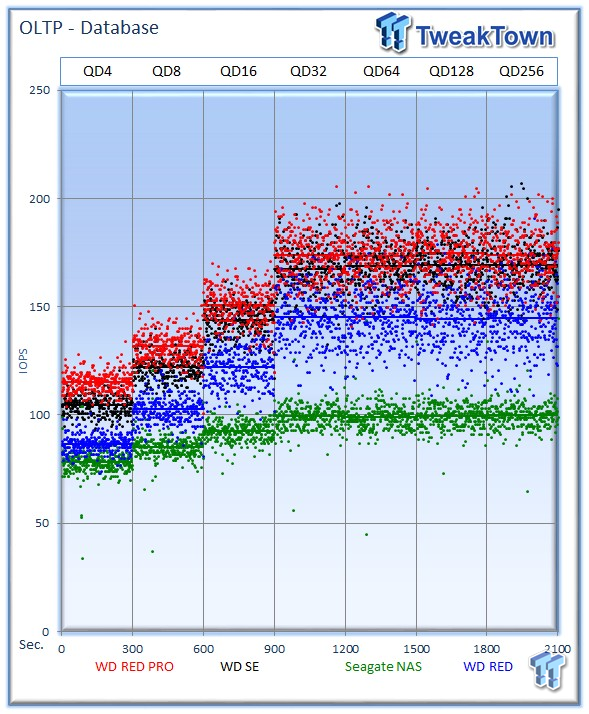
This test consists of database and On-Line Transaction Processing (OLTP) workloads. OLTP is the processing of transactions such as credit cards, and high frequency trading in the financial sector. Databases are the bread and butter of many enterprise deployments. These demanding 8k random workloads with a 66 percent read and 33 percent write distribution bring even the best solutions down to earth.
The WD Red Pro provides 173 IOPS at QD256, the WD SE averages 169 IOPS, the WD Red averages 144 IOPS, and the Seagate NAS HDD provides 99 IOPS. In this challenging mixed workload, the WD Red Pro actually outpaces its enterprise sibling, the WD SE.
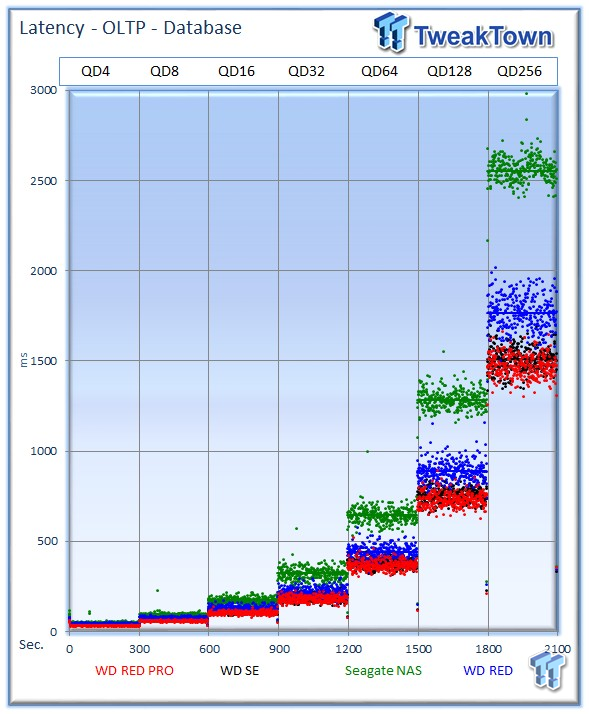
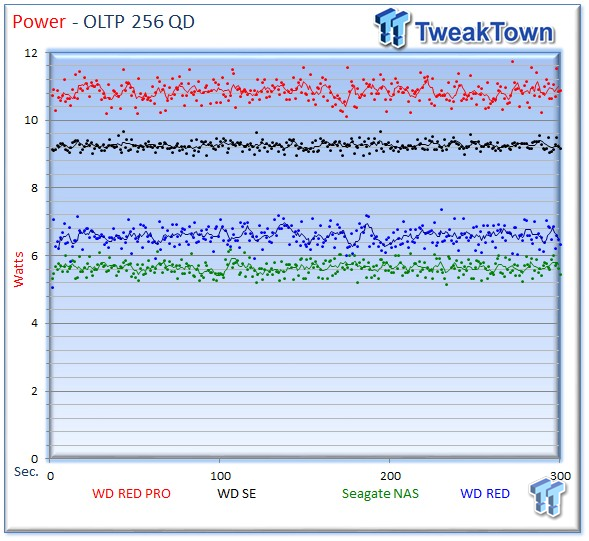
The WD Red Pro requires an average of 10.89 watts during the workload.
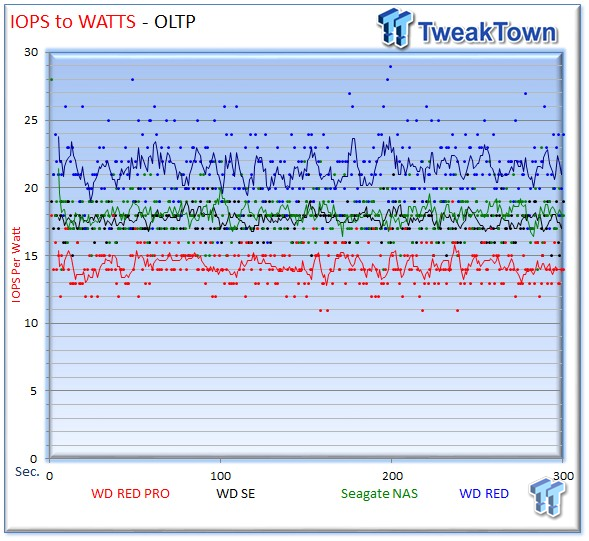
The WD Red Pro provides 14 IOPS-per-watt.
File Server
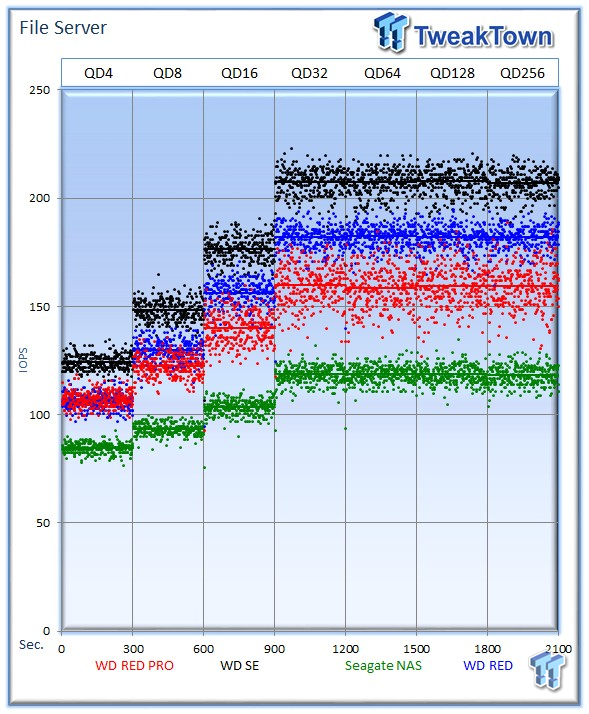
The file server profile consists of typical file server workloads. This profile tests a wide variety of different file sizes simultaneously, with an 80% read and 20% write distribution.
The WD Red pro offers 159 IOPS at QD256, and is surprisingly beaten by the original WD Red and the WD SE. The WD SE provides a chart-topping 207 IOPS, the WD Red offers 182 IOPS, and the Seagate NAS HDD provides 118 IOPS.
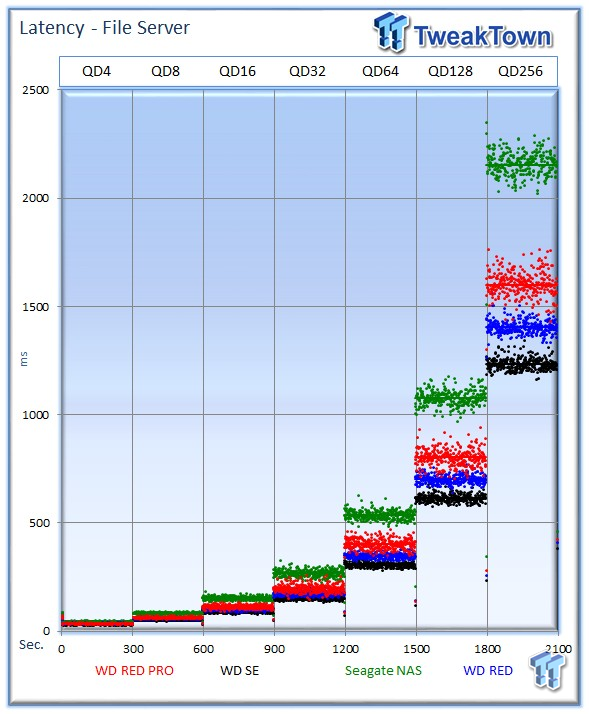
The WD SE distances itself from the pack with excellent low latency performance.
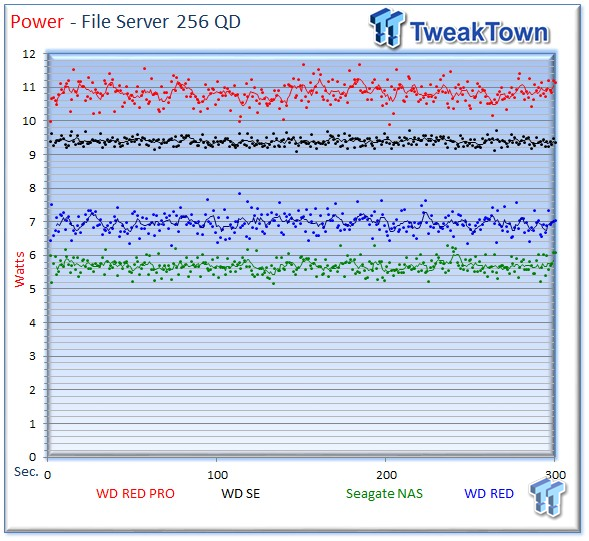
The WD Red Pro averages 10.83 watts during the fileserver workload.
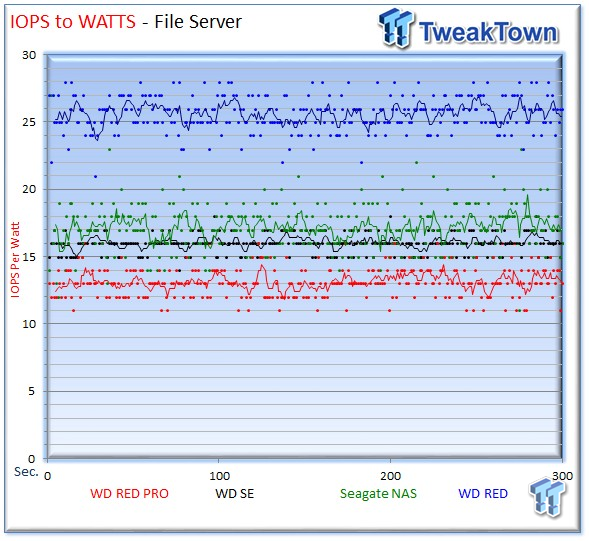
The WD Red Pro offers 13 IOPS-per-watt during the measurement window.
Benchmarks - Email Server
Email Server
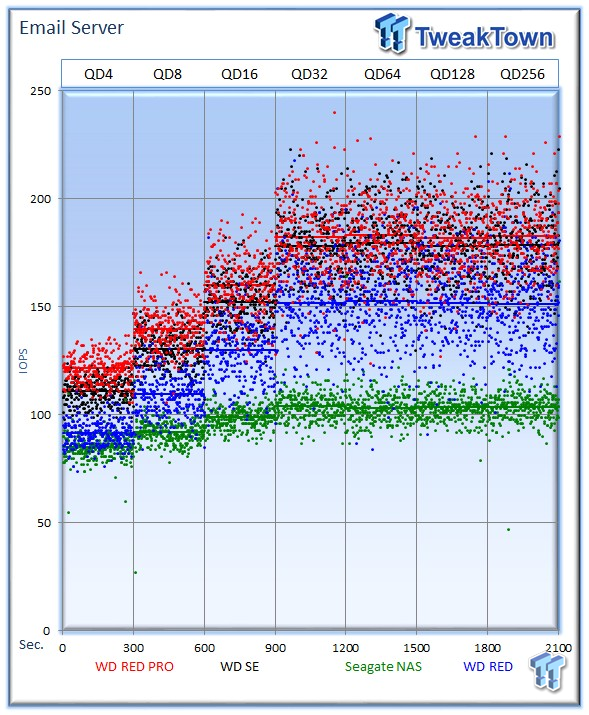
The email server workload is a demanding 8K test with a 50% read and 50% write distribution. This application is indicative of the performance in heavy write workloads.
The WD Red Pro provides an average of 182 IOPS at QD256; the WD SE averages 178 IOPS, the WD Red delivers 151 IOPS, and the Seagate NAS HDD provides 151 IOPS.
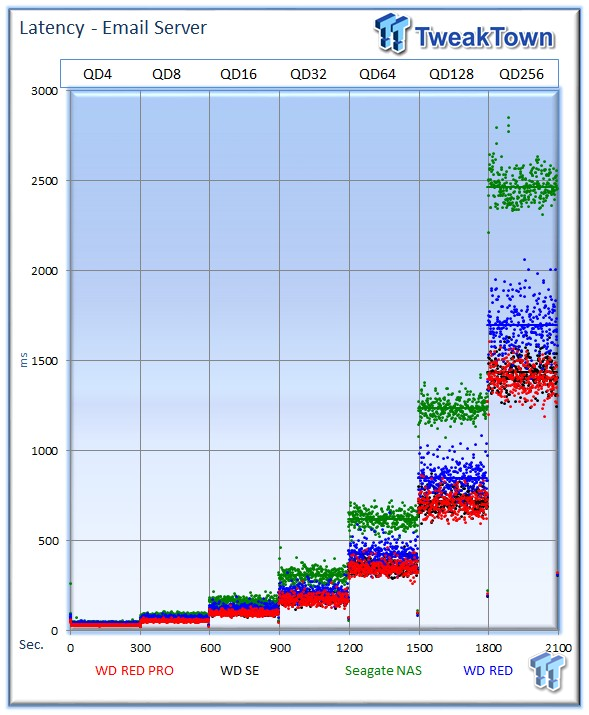
The WD Red Pro and the SE fall within a very similar latency performance envelope.
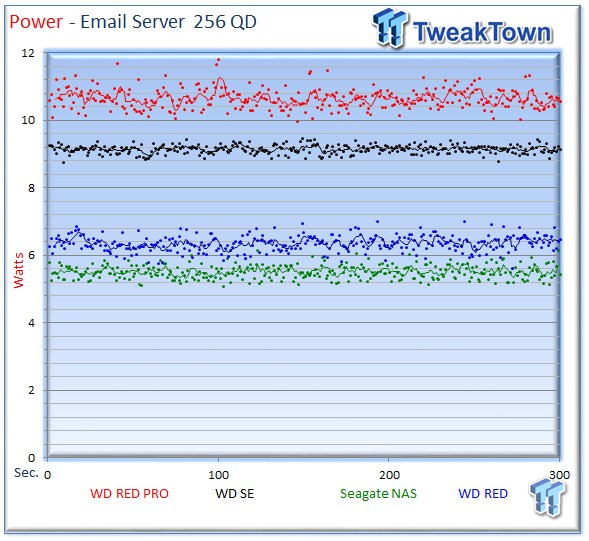
The WD Red Pro averages 10.64 watts during the email server workload.
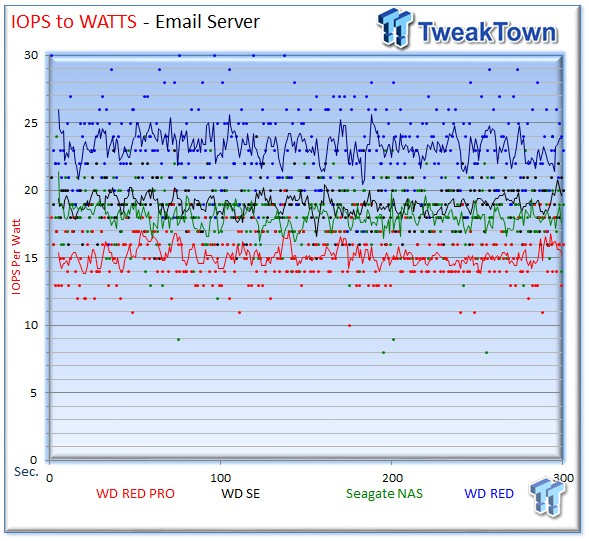
The WD Red Pro offers 15 IOPS-per-watt during the measurement window.
Final Thoughts
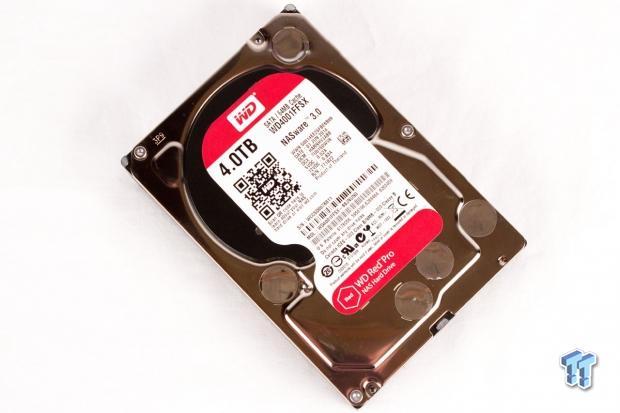
The NAS segment is experiencing more stratification as manufacturers focus on delivering refined solutions that target specific use cases. The WD Red Pro does not directly compete with the Seagate NAS HDD and the original WD Red, but we included those results as a point of reference for comparison to client NAS solutions. The WD Red Pro is geared for larger deployments, but there are always bleeding-edge users seeking performance above all other factors. The WD Red Pro will surely find its way into smaller NAS systems as well.
The WD SE and the Red Pro share many attributes in random workloads. In some cases, it appears the Red Pro is merely a rehash of the SE, but our testing found key differentiators between the two drives. Both HDDs offer robust performance that regularly outperforms the competition. The WD Red Pro provides spectacular performance that topped the charts in numerous workloads; this is due to the faster spindle speed and enhanced performance optimization for more demanding environments. The strong performance of the WD Red Pro wasn't only specific to pure read or write environments, it also provided leading performance in our mixed random testing.
The Seagate NAS HDD trailed the test pool in most tests, but a particular strength of the Seagate offering has always been its sequential speed and power efficiency. The WD Red Pro managed to unseat the Seagate NAS HDD from the top of the chart in sequential read/write workloads, and it led the pack in the demanding mixed sequential workloads. Surprisingly, the Red Pro also distanced itself by a healthy margin from the WD SE in sequential workloads.
The Red Pro's solid performance continued during our server workloads, and it easily led the transactional-based OLTP workload. The only hiccup in performance came during our fileserver workload, where it placed lower than the SE and the original Red. During the heavy random-write email workload, the Red Pro also provided faster performance than competing solutions.
The key differentiation between the WD Red Pro and the competition came down to the surface during our power testing. Higher power consumption is expected due to the faster spindle speed, but we were surprised that the Red Pro required more power than the similar speed WD SE, and fell behind the test pool in our efficiency tests. Low power consumption isn't as much of a concern in the SMB/SME segment targeted by the Red Pro, and these environments tend to feature bursty workloads that will not require constant, full utilization.
Our testing focuses on sustained performance, and the WD SE provides far more efficient power consumption metrics that may be more desirable for those with larger deployments of drives. The SE's performance is on par with the Red Pro in most random workloads, and for some, the power trade-off might not be the best option. For those looking for significantly faster sequential performance, the Red Pro will be worth the increase in power consumption.
The WD Red Pro touts enterprise class features that make it a very attractive solution for the SMB/SOHO space. The NASware 3.0 firmware provides significant performance and reliability enhancements, and the addition of hardware-based vibration resistance adds another layer of protection. A five-year warranty brings the WD Red Pro up to the enterprise grade-level, and the WD Red Pro wins our TweakTown Best Features Award.
PRICING: You can find the WD Red Pro for sale below. The prices listed are valid at the time of writing, but can change at any time. Click the link to see the very latest pricing for the best deal.
United States: The WD Red Pro (2TB) retails for $144.73 at Amazon, the WD Red Pro (3TB) retails for $179.00 at Amazon, and the the WD Red Pro (4TB) retails for $249.00 at Amazon.
Canada: The WD Red Pro (2TB) retails for CDN$194.47 at Amazon Canada, the WD Red Pro (3TB) retails for CDN$241.79 at Amazon Canada, and the WD Red Pro (4TB) retails for CDN$307.96 at Amazon Canada.
